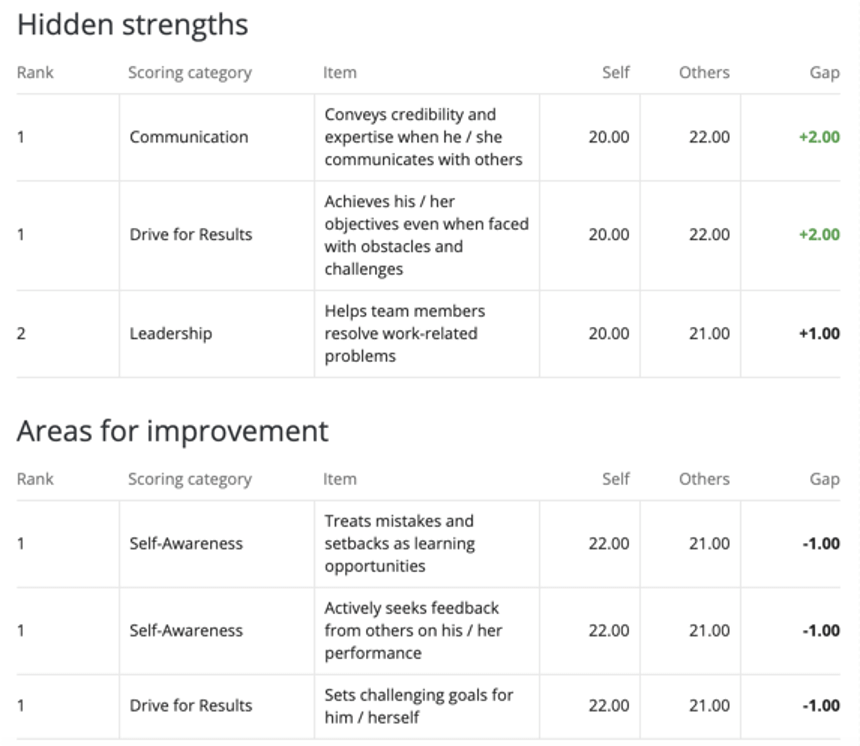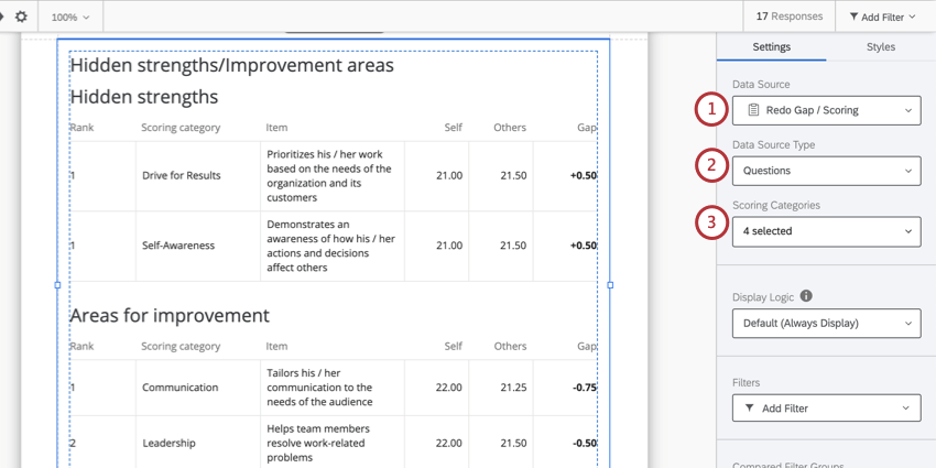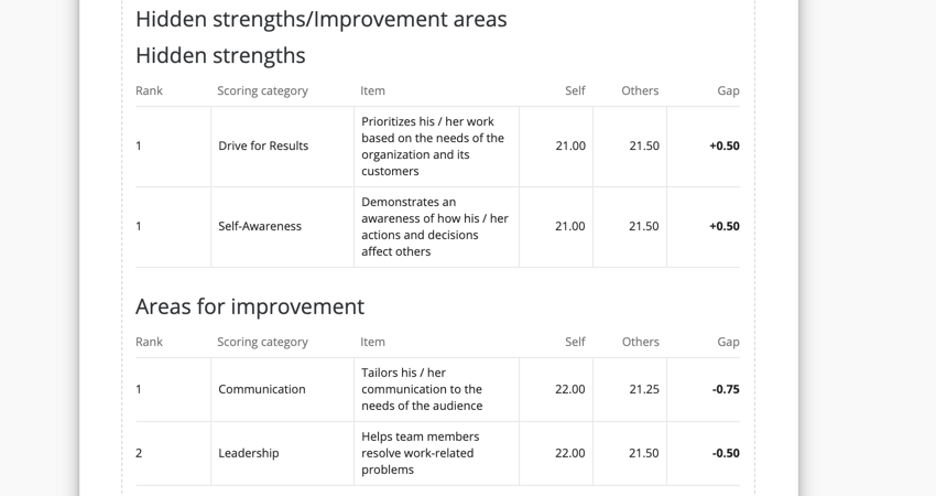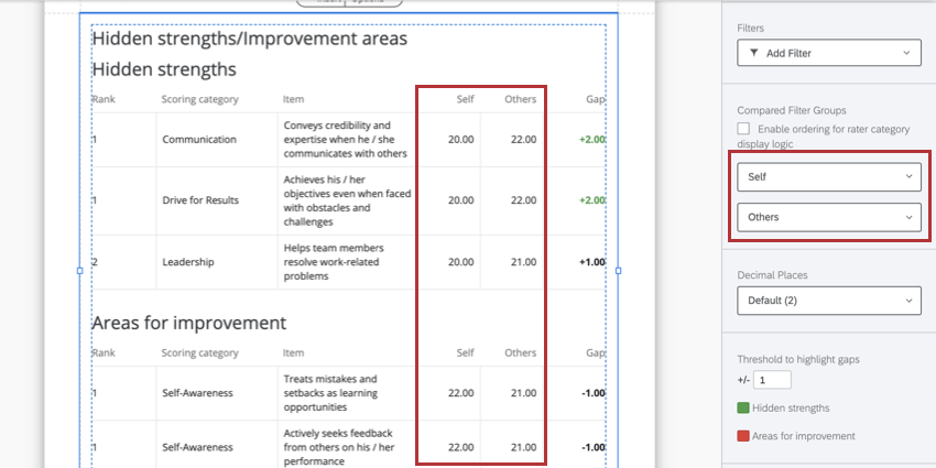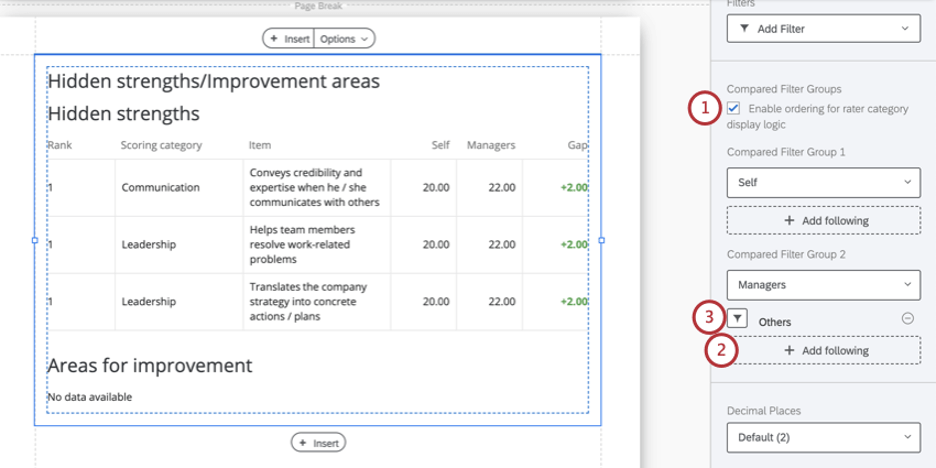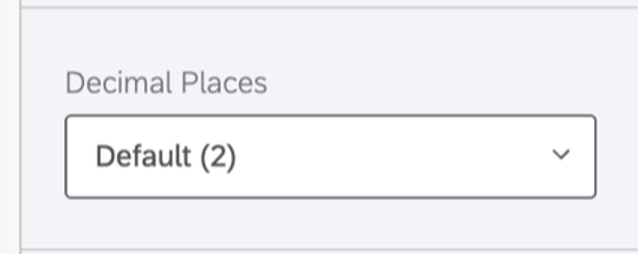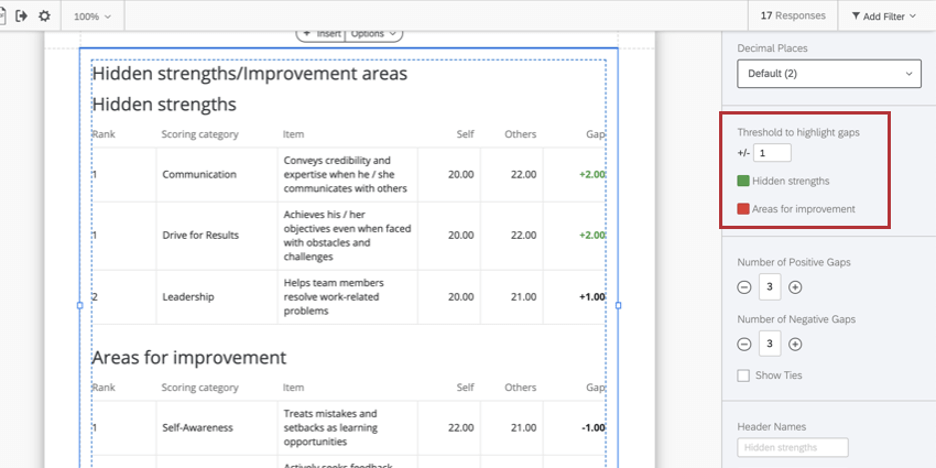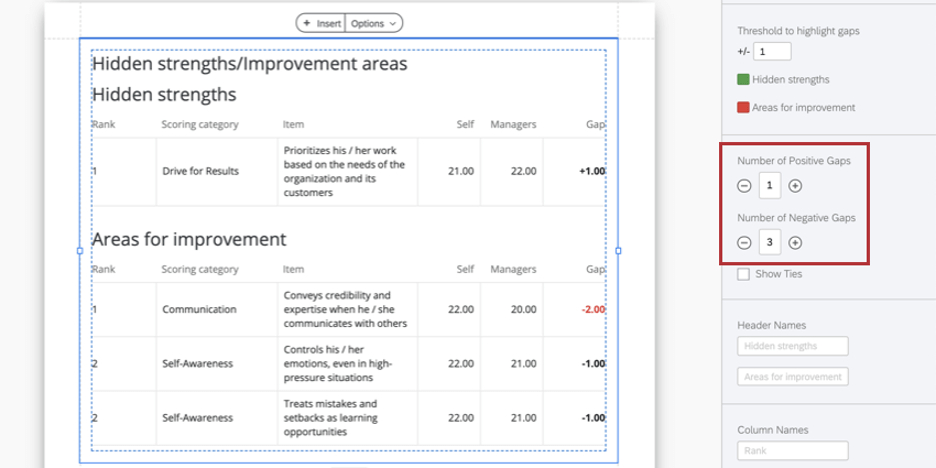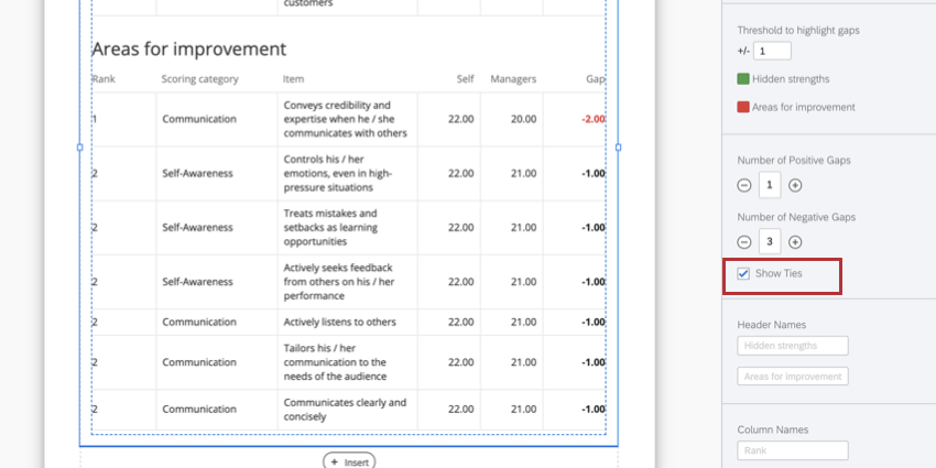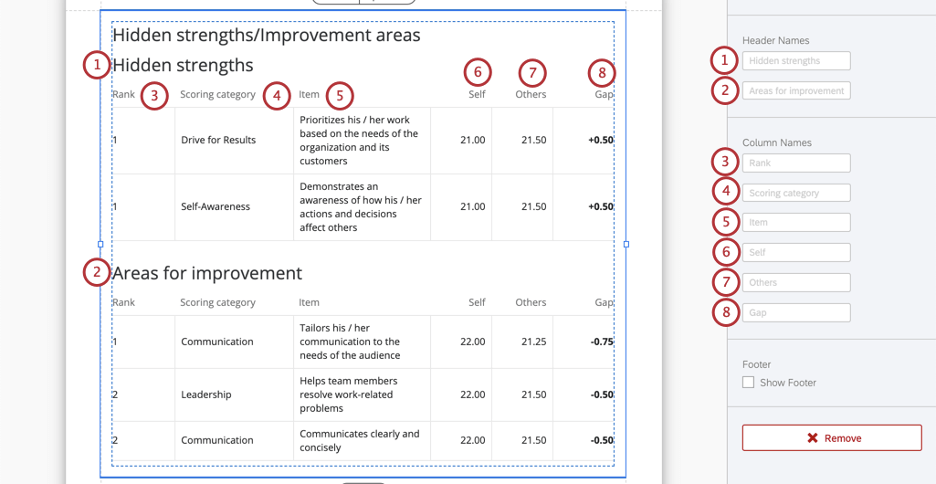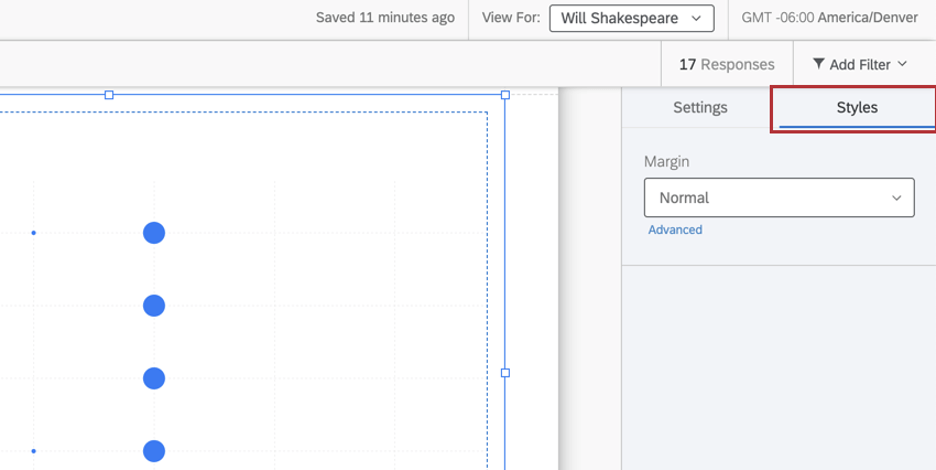Hidden Strengths / Improvement Areas Table (360)
About Hidden Strengths / Improvement Areas (360)
The Hidden Strengths / Improvement Areas table displays, by default, the subject’s five highest positive gaps and the subject’s five lowest negative gaps. Among these, the table can also highlight hidden strengths and areas of improvement (in color).
The table automatically compares data from Self and Others, but can display data from any two different rater groups. For example, you can show the gap between how colleagues rate the subject and how their manager does. The gap column is calculated by subtracting the results of the second rater group from the first rater group.
Data Source
You must set up scoring categories before you use a hidden strengths / improvement areas table in your report. This table can identify strengths and areas for improvement in two different ways: choosing from all questions in a scoring category, or choosing from overall scoring categories.
- Under Data Source, choose the project you want to pull data from. By default, this will be the 360 project you created the report in.
- Under Data Source Type, pick one of the following:
- Under Scoring Category, choose the scoring categories you want to pull highest and lowest scores from. You can pick as many as you want.
Display Logic
Display logic is a means of hiding a chart or table if not enough responses have been collected yet. It works the same way in this visualization as it does in all other 360 visualizations. See the linked page for more details.
Filters
By default, the hidden strengths / improvement areas table doesn’t have a filter attached. However, it is pulling data from “All” evaluations of the subject. This is because you can choose what rater groups you are comparing in the table.
This filter setting can be used to filter the table by other demographics or employee metadata (e.g., a specific office or region), and is not a good use for rater group filters. See 360 Basic Filtering for a guide on more general filtering.
Compared Filter Groups
Use the dropdowns to designate what filter groups should be compared in your table. By default, this is self (how the subject evaluated themselves) vs. others (how all others evaluated the subject), but it can be any two filter groups you want.
Rater Category Display Logic
Rater category display logic allows you to customize the conditions under which a rater group is displayed in reports. For example, you can set logic that allows you to hide or display a rater group under specific conditions.
If you have rater category display logic set up in your report, then you can configure your Hidden Strengths / Improvement Areas table so that other rater groups are substituted in the event that rate category display logic hides them.
- Select Enable ordering for rater category display logic.
- Underneath the filter group that might be hidden by rater category display logic, click Add following.
- Select the filter group you want to substitute.
To remove substitute filter groups, use the minus sign ( – ) next to its name. You can add multiple substitutes. The table will check them in the order they are listed.
Decimal Places
Adjust the number of decimal places displayed in numbers on the table. Pick from 0 to 5.
Threshold to Highlight Gaps
Designate the threshold where a gap becomes significant, and should be highlighted.
Positive gaps above the designated threshold will be highlighted with the color for Hidden strengths.
Negative gaps below the designated threshold will be highlighted with the color for Areas for improvement.
Example: Look at the screenshot above. Evaluators rated the subject two points higher on the item, “Conveys credibility and expertise when he / she communicates with others,” than the subject rated themselves. Because this gap is higher than the threshold of one, it is highlighted in green to indicate it is a hidden strength.
Number of Positive and Negative Gaps
Determine the number of positive gaps (“hidden strengths”) and negative gaps (“areas for improvement”) that should be included in the table. You can type a value in the field or use the plus ( + ) and minus ( – ) signs to adjust the numbers. The number of high and low rows you can have is limited by how many scoring categories or items you have in your survey.
Show Ties
Let’s say your table is set to show the three areas for improvement and three strengths. By default, the table will show only the three highest scores. If the third score displayed is “tied” with another score, this will be excluded to shorten the length of the table.
However, you can show these ties by enabling Show Ties.
When Show Ties is disabled, the chart will check up to 12th decimal place of each average score to determine which “tied” score is technically higher or lower. The highest or lowest value is then displayed in the chart.
Header and Column Names
You can edit the following header and column names. You can always return to the default names by erasing anything typed into the field. You cannot hide or remove these headers and columns.
- Hidden strengths: Header above the hidden strengths / negative gaps.
- Areas for improvement: Header above the areas for improvement / positive gaps.
- Rank: Shows above the column ranking scores against each other.
- Scoring Category: Shows above the column showing the scoring category name.
- Item: Included only if you’re displaying specific items, or questions, within a scoring category.
- Self: Will vary based on the filter groups you set.
- Others: Will vary based on the filter groups you set.
- Gap: The difference between the two filter groups’ (e.g., self and others) scores.
Footer
The footer contains the following text, which explains how the table works so subjects can better understand their reports. Select or deselect the Footer checkbox to either hide or display this footer.
The first column of scores indicates how you scored yourself. The second column indicates the average score of others. The third column indicates the difference between how you scored and how others scored you.
Styles
Switch to the Styles tab to adjust the margins around the edge of your chart. Switch to Advanced to adjust margins on each side independently of each other.
